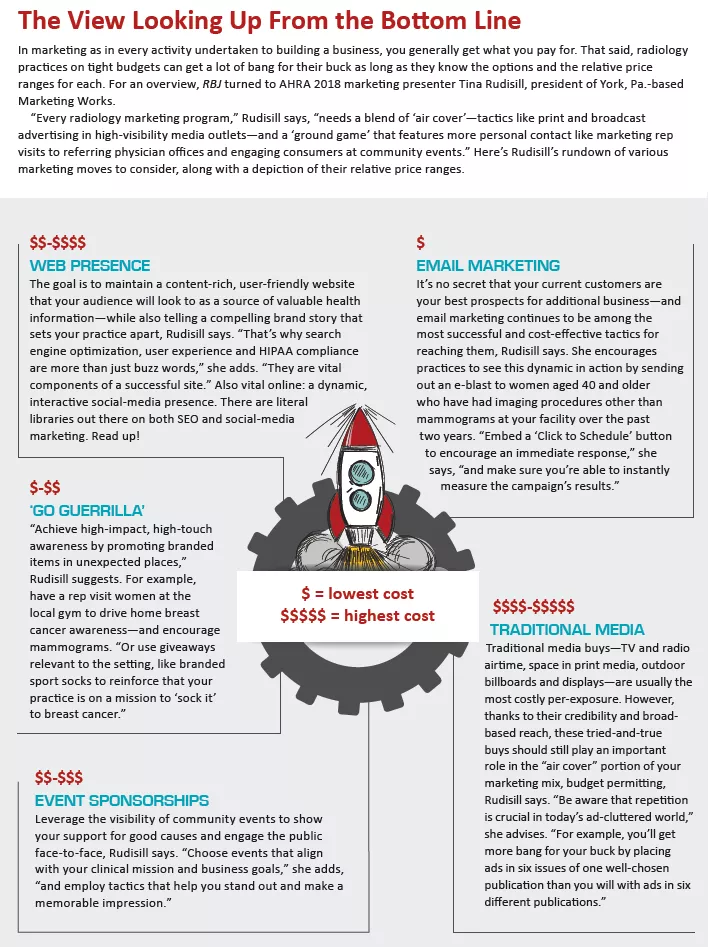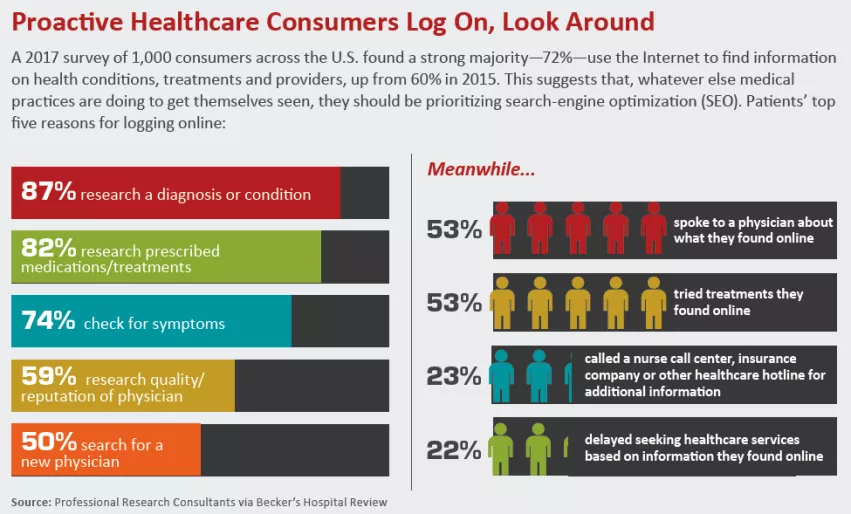Promotion in Motion: Under Pressure to Behave More Like a Business Than Ever Before, Radiology Gets on Board with Modern Marketing
Surgeons do it. So do psychiatrists, urologists, endocrinologists, orthopedists, geneticists and geriatricians.
That’s right: Across the board, medical practices in most specialties market themselves.
Whether the target audience is patients, referrers or a combination of the two, forward-thinking groups are promoting their services not only online—with paid and free social-media channels as well as websites—but also the old-school way, via display ads in newspapers and magazines, radio and TV spots, billboards, print brochures and more.
Radiology practices, not so much.
Why are radiologists resistant to joining the party? Why, at a time of rampant consolidation among hospitals and independent imaging practices—along with intensifying competition in an industry that risks being viewed as a commodity— is the mere mention of marketing and advertising likely to start eyeballs rolling?
There’s no hard data on how many rad groups are active with strategic communications, much less to what degree, but enough anecdotal evidence is afoot to suggest that a lot of self-imposed sidelining is going on.
“Outpatient radiology is a big money-maker for hospitals these days, and yet administrators just don’t understand how to properly market their practices,” says David Levin, MD, emeritus professor and chair of radiology at Thomas Jefferson University Hospital in Philadelphia. Levin lead-authored a paper published in JACR in 2016, “Marketing a Radiology Practice,” which made the case that marketing matters and laid out ways for radiology practices to successfully reach referrers, patients and/or both.
Levin and colleagues underscore that radiology is not only a medical profession but also a bona fide business. And marketing “is an important part of that business,” they write, suggesting this holds for stand-alone radiology practices and hospital radiology departments alike.
All would do well to strategically court attention so as to differentiate themselves from competitors, the authors suggest. And that shouldn’t be an optional aim at a time when sustainable autonomy is closely tied to fiscal fitness.
What’s more, marketing is a means of informing—and that’s an activity that provides real value to patients and referrers.
“You can do marketing in a very professional and informative way that benefits not just yourself and your institution but also the patient,” says Reginald Munden, MD, MBA, chair of radiology at Wake Forest Baptist Health in Winston-Salem, N.C. “The weakness we have in radiology is that most of the general public doesn’t know what we do. We need to clearly explain to them the value we provide. That’s the marketing piece we haven’t done a very good job with in the past.”
Reach Out and Wow Someone
The good news for radiology practices stuck on the fence over marketing is that some of the most enterprising ideas are low-tech and low-cost.
Giving patients access to their reports, for example, is hardly a novel concept, with more and more radiology practices doing so through secure online portals. But Thomas Jefferson University’s Levin suggests taking the initiative a step further by having the radiologist who dictated the report affix his or her name, email address and phone number to the document. This way, any patient with a question can get a quick response.
“This is good marketing,” Levin says. “It lets the patient know there is a real doctor at the other end of that report who is making himself or herself available to help. It creates a good feeling for the patient.”
In the same spirit of bonhomie, Levin believes that radiology groups should take a more aggressive role in the ongoing management of patients’ imaging care by contacting them directly—albeit with prior approval of the referring physician—to make arrangements for follow-up studies, when recommended.
“Almost every radiology practice relies on the referrer to make sure the patient comes back in, say, six months for a CT scan,” he explains. “But here’s a chance for the radiologist to take ownership. The patient will appreciate the attention and concern from the radiologist, and the referring physician will appreciate the fact they have one less thing to worry about.”
Interestingly, as imaging centers work to better define themselves, they may find that trumpeting cutting-edge technology carries little cachet with customers. “The technology piece is expected,” says Tina Rudisill, owner and president of York, Pa.-based Marketing Works, a strategic-communications agency whose client roster is heavy with healthcare providers. Rudisill presented on marketing at RBMA 2018 with Marketing Works client Marc Rothenberg, chief operating officer of six-site Princeton Radiology in New Jersey.
“People will review us and rate us on based on all those things that have absolutely nothing to do with the clinical side,” Rudisill says. “That’s why we look for every opportunity to interact with patients and find ways to enhance their experience.”
For women turning 40, that journey may begin with a birthday card from Princeton Radiology and a timely if not-so-subtle reminder to schedule their first mammography. This marketing foray, which has proven highly successful, is sweetened with the offer of discount merchandise and a makeover from a local big-name retailer for 40-somethings who call to schedule an exam.
That’s not the only way Princeton Radiology woos women for mammograms, Rudisill notes. The practice launched a campaign for its branded and trademarked mammography service, SmartMamm, with an eye-catching ad that ran not only on its website but also in print media and on outdoor billboards. The ad showed the outline of a polka-dot bikini top on a wire hanger with the cheeky headline, “It’s really smart to go topless here once a year.”
Another ad for the group’s new extremity MRI service featured a woman with outstretched arms in a difficult yoga pose encouraging the public to “say goodbye to claustrophobia and hello to a calming, comfortable MRI experience.”
Rudisill stands by Princeton Radiology’s bold creativity. “Practices have to be a little edgy today,” she says, “and be willing to take risks to get noticed.”
A Winning Web Presence
An inviting and polished website, of course, is an obligatory part of any medical practice’s modern marketing mix. According to Levin, for your virtual kiosk in cyberspace is to attract visitors and influence them, it needs to offer not just pro forma information on services, programs and locations but also feel-good, consumer-friendly content. Impactful elements might include:
- A message from (or video of) the head of the practice welcoming customers to the site and, by extension, to the practice;
- A statement about who radiologists are and what they do;
- A list of all insurance plans accepted by the practice and a number to call to get help with billing questions or problems;
- A statement on quality and how it’s pursued and monitored;
- A word about what the practice does to minimize radiation exposure; and
- The latest news on awards and accomplishments of imaging center members.
Meanwhile, search-engine optimization (SEO) has become more science than art, and so has pay-per-click (PPC) advertising on Google, Yahoo, Bing and other search engines. These subtopics are deep enough to warrant an article all their own for practices looking to seriously increase website traffic. In this space, suffice it to say that those terms, SEO and PPC, warrant a search all their own, as there are plenty of free and paid resources explaining the general concepts and fleshing out the proven particulars.
Radiology practices with the means and the will are increasingly seeing value in running a comprehensive digital marketing program (of which SEO and PPC are a part). In just the first six months of its own digital marketing plan, for example, Princeton Radiology’s homepage drew more than 2,000 visitors who clicked ads posted online for three targeted marketing campaigns. No less impressive were the 976 imaging appointments—including for 385 new patients—arranged electronically.
Creativity Counts
Online visitors, however, constitute only a slice of the overall customer set that radiologists need to actively engage. Other key audiences include referring physicians, private payers and hospital administrators. Each of these subgroups warrants dedicated marketing strategies, tactics and to-do’s.
In fact, the gold standard was and remains a radiologist or staff member focused on marketing and willing to make “house calls” to existing and prospective referrers.
That may not be doable for most. Either way, in increasingly competitive times like these, even contracted radiology practices embedded in hospitals or across healthcare systems can ill afford to retreat to their dark rooms and ignore the fact that, at some point, they could be replaced by a hungrier, more marketing-savvy group. More than ever, hospitals are looking for partner practices willing and able to align themselves with the mission, vision and reputation of the hospital.
And this means actively increasing face time, the experts agree.
“Radiologists need to be part of hospital committees,” says Munden, who authored a 2015 JACR paper on marketing and branding for radiologists. “And they need to get involved at the leadership level of the hospital at the same time they’re building relationships with hospitalists, internists, ED docs and others on the front lines of patient care. They are all our allies and it’s important that they see we have a vested interest in the hospital and are committed to its success.”
There are other effective ways for radiologists to burnish their brand. One is through print and/or digital newsletters targeted to administrators and physicians who make business decisions. Topics for articles and items might include new equipment and procedures, changes to guidelines, ways to reduce unnecessary tests, updates on research and presentations given locally by radiologists.
Customer satisfaction surveys can also be a surprisingly useful marketing tool for radiologists whether they work inside or outside the hospital. Proponents say these surveys should be snail-mailed or emailed to patients right after an exam and to referring physicians once or twice a year.
Why bother with an exercise that’s often perceived as perfunctory? “It lets us know which sites are offering a better customer experience than others,” explains Rothenberg of Princeton Radiology, which operates through a network of eight imaging centers and four hospitals. “Our internal statistics might tell us that everyone is being taken for their exam within 10 to 15 minutes of arrival. But we don’t know if that meets our patients’ expectations unless we actually ask them.”
And don’t overlook opportunities inherent to social media. With a cost of entry under $10 a day, for example, Facebook advertising allows low-risk experimentation with messaging, targeting and audience segmentation. And that can work well on top of organic (i.e., free) likes, comments, retweets and shares.
Tying In the Human Touch
For all the emphasis on bleeding edge technologies and techniques, as alluded to earlier, marketing a radiology practice today often boils down to old-fashioned legwork. And that means having a stable of knowledgeable representatives who are qualified to serve as “brand ambassadors.”
These might be physician liaisons equipped to go beyond the requisite bagels-and-donuts runs and discuss in depth with referrers and their staffs what makes your practice unique. Ideally, they should be provided with the latest customer-relationship management (CRM) software to streamline their physician-prospecting activities and monitor their progress and impact on the overall business.
These customer reps can also do double-duty as the face of your business within the community, particularly at health fairs, charitable events and other activities where just mingling with the public can send a powerful message. Some practices further meld civic responsibility with marketing prowess by sponsoring mobile vans that fan out through low-income neighborhoods to free or low-cost screening services such as mammography.
There’s another way a radiology practice can demonstrate its commitment to public health while simultaneously drumming up new business—one that radiologists seldom seem to consider. That’s offering inexpensive imaging exams to individuals who are concerned about certain health risks but have high-deductible health plans or lack coverage altogether.
CT coronary calcium scoring is a good candidate for such a program, says Levin, because it’s a widely desired test for cancers of the breast, colon and lung as well as for coronary artery disease—and because few insurers pay for it. He cites one enterprising center that offered the test for $99 as a loss leader and heavily advertised the deal to the community. Centers may be able to justify campaigns like these by scheduling tests during evenings or on weekends when they have available capacity on their scanners.
A Marketing Mindset
Because marketing is seldom counted among the innate talents of people running radiology departments or independent practices, it often takes a professional skilled in the trade to kick-start a meaningful program or turbocharge one that’s never quite taken flight.
This could mean hiring an experienced, full-time marketing tactician to join the staff, assemble a team, and develop a multi-pronged marketing plan that filters down to everyone in the organization.
Or it could mean partnering with an outside marketing firm or agency with the kinds of big ideas and bold concepts that radiologists facing a stew of competitive, pricing, regulatory and financial pressures may need to survive.
Either way, it requires an across-the-board commitment.
“Marketing may start at the top, but it’s really a companywide effort,” says Rothenberg. “It includes the whole customer-experience chain, from how you greet patients on the phone when they schedule an exam to how you take care of them when they enter your office. It takes a compelling message—but, just as importantly, it requires that everybody has the right mindset and the right follow-through.”


